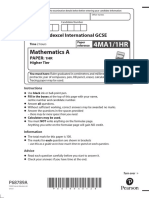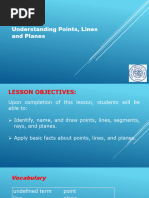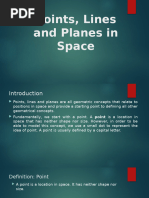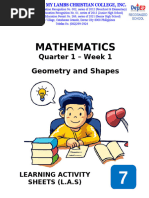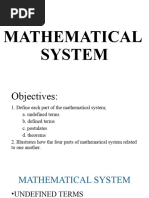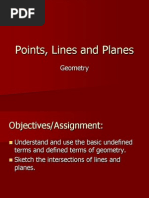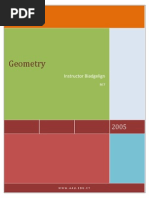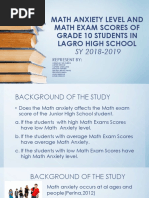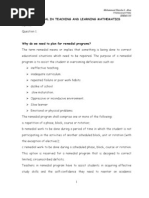Sec 1.3 Geom
Sec 1.3 Geom
Uploaded by
rishab.balaji19Copyright:
Available Formats
Sec 1.3 Geom
Sec 1.3 Geom
Uploaded by
rishab.balaji19Copyright
Available Formats
Share this document
Did you find this document useful?
Is this content inappropriate?
Copyright:
Available Formats
Sec 1.3 Geom
Sec 1.3 Geom
Uploaded by
rishab.balaji19Copyright:
Available Formats
Section 1.
3 Points, Lines, and Planes
Objective 1: Learning Terms and Postulates of Geometry
The following table describes three undefined terms of Geometry, how to name these terms, and
gives an example of each.
Description How to Name It Example
A point has no dimension Name a point by a
(no length, width, or single capital letter.
height). It does have a
location or position.
A line extends in opposite Name a line by a
directions without end single lowercase
and has one dimension— letter or by any two
length. points on the line.
A plane extends in two Name a plane by a
dimensions without end. single capital letter
The two dimensions are or by any three
length and width, but no points on the plane
thickness. We represent a (that do not lie on
plane by a flat surface. the same line).
Collinear points are points that lie on the same line.
Coplanar points are points that lie on the same plane.
a. Use the figure shown below to answer the following questions:
i. Name two other ways to name line .
ii. Name two other ways to name plane C.
iii. Name three collinear points.
iv. Name four coplanar points.
Space is the set of all points in three dimensions.
A geometric figure is any nonempty subset of space.
Another undefined term is between. In the figure below, points A, B, C, and D all lie on the same
line. Point B is between points A and C as well as between points A and D.
However, in the next figure, point B is not between points A and C because point B does not on the
same line as points A and C.
The following table describes some defined terms, how to name them, and gives an example of each.
Definition How to Name It Example
A line segment or simple Name a segment by
segment is part of a line. It its end points:
consists of two endpoints and (segment AB) or
all the points between them.
(segment BA)
A ray is part of a line. It Name a ray by its
consists of an endpoint and endpoint and any
all points of the line on one other point on the
side of the endpoint. ray. The order of
the points is
important here—
list the endpoint
first. (ray AB) is
not the same as
(ray BA)
Opposite rays are two rays Name each
that share the same endpoint opposite ray as you
and form a line. would name a ray.
Postulate: Two Points Determine a Line
Through any two points there is exactly one line.
In the figure below, line t passes through points A and B. Line t is the only line that passes through
both points.
The intersection of two or more geometric figures is the set of points that the figures have in
common.
Postulate: Intersection of Lines
If two distinct lines intersect, then they intersect at exactly one point.
In the figure below, lines m and n intersect at point C.
b. Use the figure shown below to answer the following:
i. Name five points.
ii. Name three rays.
iii. Name four segments.
iv. Name a pair of opposite rays.
v. Are rays and opposite rays?
Postulate: Intersection of Planes
If two distinct planes intersect, then they intersect in exactly one line.
In the figure below, plane RST and plane WST intersect in line .
Postulate: Three Noncollinear Points Determine a Plane
Through any three noncollinear points there is exactly one plane.
Points Q, R, and S are noncollinear. Plane P is the only plane that contains them.
Hint: Do not forget the three points must be noncollinear. If the three points are collinear, many
planes will pass through the three points!
c. Use the figure below to answer the following questions:
i. Name the intersection of planes QRS and TGF.
ii. Name the intersection of planes HEF and SER.
iii. Name two planes that intersect in line .
iv. Name the intersection of planes TSF and HES.
v. Name a point that is coplanar with Q, T, and G.
vi. Name a point that is coplanar with R, S, and G.
d. Plot the points on a coordinate plane and state whether they appear to be collinear or not.
i. (0, 0), (-3, 4), (5, -3)
ii. (-1, -1), (2, 2), (4, 4)
You might also like
- The Building Blocks of GeometryDocument11 pagesThe Building Blocks of GeometryTweetie100% (5)
- Edexcel IGCSE Mathematics A June 2022 Question Paper-1HR - 4ma1-1hr-Que-20220521Document28 pagesEdexcel IGCSE Mathematics A June 2022 Question Paper-1HR - 4ma1-1hr-Que-20220521Maya hussamNo ratings yet
- Math-8 Q3 LAS Week1Document16 pagesMath-8 Q3 LAS Week1Aryan Francis LampitocNo ratings yet
- 1-3 Points, Lines, and PlanesDocument4 pages1-3 Points, Lines, and PlanesTrevor StrengNo ratings yet
- 1 - Mathematical System in GeometryDocument19 pages1 - Mathematical System in GeometryjjqtplaysNo ratings yet
- Plane and Solid Geometry Module 1Document13 pagesPlane and Solid Geometry Module 1Jeorge Hugno100% (1)
- Geometry Module 1Document33 pagesGeometry Module 1Prince AmazonaNo ratings yet
- Geometry LessonDocument19 pagesGeometry LessonРоджер БарреттNo ratings yet
- Lesson 1.1 Understanding Points, Lines and PlanesDocument22 pagesLesson 1.1 Understanding Points, Lines and PlanescindyqymNo ratings yet
- Points, Lines and Planes in SpaceDocument33 pagesPoints, Lines and Planes in SpaceAyade, Realene, MarfilNo ratings yet
- Lines, Planes, and SeparationDocument22 pagesLines, Planes, and Separationaldinette88% (8)
- EASE Module 1 Geometry of Shape and SizeDocument27 pagesEASE Module 1 Geometry of Shape and Sizemonera mohammad0% (1)
- Lesson 30 (Geometry) - Basic Concepts and Terms - LGDocument10 pagesLesson 30 (Geometry) - Basic Concepts and Terms - LGSwag Mooshroom100% (1)
- Undefined Terms of GeometryDocument1 pageUndefined Terms of GeometryMerryshyra MisagalNo ratings yet
- Geometry of Shape and Size: What You Are Expected To Learn?Document145 pagesGeometry of Shape and Size: What You Are Expected To Learn?Mhavy Pabanil Dela CruzNo ratings yet
- 1-2 PowerPoint PRESENTATIONDocument12 pages1-2 PowerPoint PRESENTATIONRS DulayNo ratings yet
- Grade 7Document24 pagesGrade 7Andrea SenecaNo ratings yet
- 1-2: Points, Lines, and Planes: Basic Geometry TermsDocument12 pages1-2: Points, Lines, and Planes: Basic Geometry TermsMark Jomil ReyesNo ratings yet
- Intro To GeometryDocument73 pagesIntro To GeometryMr. Rhumer LanojanNo ratings yet
- Fundamental Properties For Writing A Two Column ProofDocument11 pagesFundamental Properties For Writing A Two Column Proofgv2rodrigo0803No ratings yet
- Activity 1 Points, Lines, and Planes: Section 1.1Document17 pagesActivity 1 Points, Lines, and Planes: Section 1.1muhammad junaid ammarNo ratings yet
- Mathematical SystemDocument18 pagesMathematical Systemstephaniemaala400% (1)
- GEOMETRY IDocument115 pagesGEOMETRY ISadiq MarwatNo ratings yet
- Geometry 1 - 1 Intro To Geometry HandoutDocument40 pagesGeometry 1 - 1 Intro To Geometry HandoutAlma ReynaldoNo ratings yet
- Geometry Section 1 1Document9 pagesGeometry Section 1 1api-262621710No ratings yet
- Geometry 1.1 NotesDocument4 pagesGeometry 1.1 NotesErinNo ratings yet
- Grade 7Document22 pagesGrade 7Andrea SenecaNo ratings yet
- GEOM Chapter 01A2Document138 pagesGEOM Chapter 01A2mckaylabremNo ratings yet
- LAS Q3math8 - Q3 - wk2 - Melano For SubmissionDocument12 pagesLAS Q3math8 - Q3 - wk2 - Melano For SubmissionFlorame Algarme MelanoNo ratings yet
- Points Lines and Planes PowerpointDocument40 pagesPoints Lines and Planes PowerpointAlisha Akther100% (1)
- 1.2 Points Lines and Planes PowerpointDocument40 pages1.2 Points Lines and Planes Powerpointcorrzz owthreeNo ratings yet
- Q3 Math 7 Week 1 Module 1 Jeston SudiacalDocument19 pagesQ3 Math 7 Week 1 Module 1 Jeston SudiacalARIEL V. ABANESNo ratings yet
- Postulates and TheoremsDocument44 pagesPostulates and Theoremsdokka.quokkaNo ratings yet
- Geometry Ch.1 - Point,Line,Plane (Liliane's Copy)Document20 pagesGeometry Ch.1 - Point,Line,Plane (Liliane's Copy)kingjawad996688No ratings yet
- Points Lines and PlanesDocument23 pagesPoints Lines and PlanesYoAmoNYCNo ratings yet
- Sis Geometri HibertDocument6 pagesSis Geometri HibertmardinomalokyNo ratings yet
- Geometry STD 9 Maharashtra SSCDocument20 pagesGeometry STD 9 Maharashtra SSCHrishikesh Kodmur50% (2)
- Lesson 3 Mathematical SystemDocument35 pagesLesson 3 Mathematical SystemKhalil Jolo JesuraNo ratings yet
- The Postulate System of HilbertDocument2 pagesThe Postulate System of HilbertLaelatulDhianPermataNo ratings yet
- Mathematical System q3.1Document6 pagesMathematical System q3.1Ma. Vicenta FerrerNo ratings yet
- Maimoona: SUBMITTED BY: Adroiterz Hafsa Iqbal 136 Anam Maqsood 134 Aisha Fareed 135Document27 pagesMaimoona: SUBMITTED BY: Adroiterz Hafsa Iqbal 136 Anam Maqsood 134 Aisha Fareed 135Hafsa IqbalNo ratings yet
- Basics of GeometryDocument2 pagesBasics of GeometryCK-12 FoundationNo ratings yet
- Geometry 8 - Reviewer Q1Document6 pagesGeometry 8 - Reviewer Q1Grace Anne MercadoNo ratings yet
- Detailed Lesson PlanDocument9 pagesDetailed Lesson PlanJESSA CANOPINNo ratings yet
- GeometryDocument60 pagesGeometryAmelita Tupaz100% (1)
- Geometry Lecture NoteDocument180 pagesGeometry Lecture NoteMiliyon Tilahun100% (4)
- Chapter 5-MathsDocument13 pagesChapter 5-MathsChitturi SushanthNo ratings yet
- Mathematics: Guided Learning Activity KitDocument16 pagesMathematics: Guided Learning Activity KitJaeda BaltazarNo ratings yet
- ACTIVITY2Document3 pagesACTIVITY2Sheryl BorromeoNo ratings yet
- Illustrating Axiomatic Structures of A Mathematical System - Quarter 3Document66 pagesIllustrating Axiomatic Structures of A Mathematical System - Quarter 3Jeal Amyrrh Caratiquit100% (2)
- UNIT 1 - Lesson 1 & 2Document15 pagesUNIT 1 - Lesson 1 & 2Celina MarraNo ratings yet
- Geometric Designs: Basic ConceptsDocument22 pagesGeometric Designs: Basic ConceptsRye FelimonNo ratings yet
- G8 - Postulates and TheoremsDocument36 pagesG8 - Postulates and TheoremsSultana FeveyroseNo ratings yet
- 1-2 Points, Lines, Planes PDFDocument6 pages1-2 Points, Lines, Planes PDFJoseph Samuela MendivelNo ratings yet
- Geometry 1-1 Practice: Points, Lines, and Planes: Name - Period - DateDocument2 pagesGeometry 1-1 Practice: Points, Lines, and Planes: Name - Period - DateAla AjajNo ratings yet
- Geometry Notes Unit 1 Honors32Document7 pagesGeometry Notes Unit 1 Honors32api-296326751No ratings yet
- Basic Geometry ConceptsDocument4 pagesBasic Geometry ConceptsmlaasyapriyaNo ratings yet
- Suur Suur Suur Suur Sur Sur: Example 1 Name Lines and PlanesDocument3 pagesSuur Suur Suur Suur Sur Sur: Example 1 Name Lines and PlanesmikeNo ratings yet
- Geometry 1.1 HWDocument4 pagesGeometry 1.1 HWAlex VistaNo ratings yet
- Trifocal Tensor: Exploring Depth, Motion, and Structure in Computer VisionFrom EverandTrifocal Tensor: Exploring Depth, Motion, and Structure in Computer VisionNo ratings yet
- Discrete Probability DistributionsDocument64 pagesDiscrete Probability DistributionsalaaNo ratings yet
- Latihan SiapDocument7 pagesLatihan Siapainan munaNo ratings yet
- Math 21b - Homework 01Document2 pagesMath 21b - Homework 01mhersherNo ratings yet
- Analog and Digital Signals Are Used To Transmit InformationDocument49 pagesAnalog and Digital Signals Are Used To Transmit Informationniiks119No ratings yet
- Full Vector Variational Inequalities and Vector Optimization: Theory and Applications 1st Edition Qamrul Hasan Ansari PDF All ChaptersDocument52 pagesFull Vector Variational Inequalities and Vector Optimization: Theory and Applications 1st Edition Qamrul Hasan Ansari PDF All Chaptersosasehafdh100% (3)
- WK2-Math-G6-H.W Practice Sheet 2Document2 pagesWK2-Math-G6-H.W Practice Sheet 2eslamahmed.mcNo ratings yet
- Split String in ExcelDocument3 pagesSplit String in ExcelYamini ShindeNo ratings yet
- Cbse X.maths Term I Practice PaperDocument5 pagesCbse X.maths Term I Practice PaperSach BalwaniNo ratings yet
- I PU New Question BankDocument20 pagesI PU New Question BankChrisNo ratings yet
- RT SRTDocument4 pagesRT SRTrosalito pepitoNo ratings yet
- 6th Class SA 1 Maths Model Paper 4 GSR INFO-www.gsrmaths.inDocument4 pages6th Class SA 1 Maths Model Paper 4 GSR INFO-www.gsrmaths.inBaji Janjanam (CHANAKYA)No ratings yet
- ch03 Sol FG 10thDocument83 pagesch03 Sol FG 10th김서진No ratings yet
- Guide To GamelinDocument181 pagesGuide To GamelinDonutdealer100% (1)
- An Approach To Upsc Cse by Arpit Gupta (Air-54)Document11 pagesAn Approach To Upsc Cse by Arpit Gupta (Air-54)amanNo ratings yet
- Adobe Scan Dec 16, 2023Document10 pagesAdobe Scan Dec 16, 2023shreyanshbabber29No ratings yet
- Analysis of Numerical Schemes - IITMDocument32 pagesAnalysis of Numerical Schemes - IITMAchuta Murali Karthik VankayalaNo ratings yet
- Rohini 50026617495Document6 pagesRohini 50026617495Atika HussainNo ratings yet
- Math Anxiety Level and Math Exam Scores of Grade 10 Students in Lagro High SchoolDocument27 pagesMath Anxiety Level and Math Exam Scores of Grade 10 Students in Lagro High SchoolEmerald del PuertoNo ratings yet
- IOQM_Sep_2024-25_Question-paper-with-answer-keyDocument9 pagesIOQM_Sep_2024-25_Question-paper-with-answer-keymayankmandhiyaNo ratings yet
- Proforma Mte 3102 - Mathematics Education CurriculumDocument3 pagesProforma Mte 3102 - Mathematics Education CurriculumMUHAMMAD RIDHUAN BIN HANAFINo ratings yet
- Q2 Math3Document5 pagesQ2 Math3Yunilyn GallardoNo ratings yet
- Ch-5 RD MathsDocument61 pagesCh-5 RD MathsThe VRAJ GAMESNo ratings yet
- PMC Answers 2013 - 2Document2 pagesPMC Answers 2013 - 2Sivashankar NagappanNo ratings yet
- Multivariate Analysis (Minitab)Document43 pagesMultivariate Analysis (Minitab)Ankur SharmaNo ratings yet
- Signals and Systems: Lecture NotesDocument107 pagesSignals and Systems: Lecture Notesb7qxnnm8mzNo ratings yet
- Lecture 6 PDFDocument13 pagesLecture 6 PDFAbd Elmohsen MustafaNo ratings yet
- (A (A+b) A+b (A+b) B) : Sample Test Two (From Last Year Covering 3.1-3.3, 4.1, 4.3)Document1 page(A (A+b) A+b (A+b) B) : Sample Test Two (From Last Year Covering 3.1-3.3, 4.1, 4.3)陳星雨No ratings yet
- Pythagorean NumerologyDocument14 pagesPythagorean NumerologypalharjeetNo ratings yet
- Assignmt REMEDIALDocument16 pagesAssignmt REMEDIALrisliNo ratings yet

